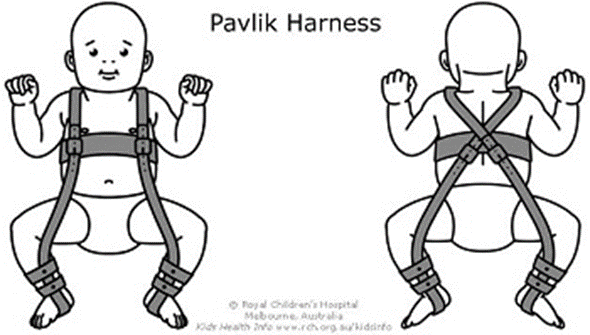A nurse is reinforcing teaching with the mother of a 2-month-old infant whose provider applied a Pavlik harness 1 week earlier for the treatment of developmental hip dysplasia.
Which of the following statements by the mother indicates an understanding of the teaching?
"I will adjust the harness straps every day.".
"I will place the diaper over the harness.".
"I will gently massage lotion on his skin around the harness clasps.".
"I will check my baby's skin three times each day.".
The Correct Answer is D
Checking the baby’s skin three times each day can help the mother monitor for any skin irritation or breakdown caused by the harness.
This can help prevent complications and ensure that the harness is being used safely and effectively.

Choice A is not the best answer because the mother should not adjust the harness straps on her own.
This should be done by a healthcare provider to ensure that the harness is properly fitted.
Choice B is not the best answer because the diaper should be placed under the harness, not over it.
Choice C is not the best answer because massaging lotion on the skin around the harness clasps may not be necessary and could potentially cause skin irritation.
Nursing Test Bank
Naxlex Comprehensive Predictor Exams
Related Questions
Correct Answer is C
Explanation
Amniotic fluid helps cushion the baby12.
It acts as a shock absorber and protects the fetus from injury should the mother’s abdomen be subject to trauma or sudden impact.
Choice A is incorrect because the amniotic fluid does not provide oxygen to the fetus.
Oxygen is provided to the fetus through the umbilical cord.
Choice B is incorrect because amniotic fluid is not how the baby is fed. The baby receives nutrients through the umbilical cord.
Choice D is incorrect because while amniotic fluid does have some antibacterial properties2, it does not prevent viruses from passing to the baby.
Correct Answer is A
Explanation
Muscular dystrophies are disorders associated with progressive degeneration of muscles, resulting in relentless and increasing weakness.
This is a general description of muscular dystrophy, a group of genetic diseases that affect different types of muscles and cause various degrees of disability.
Children with muscular dystrophy may experience frequent falls, difficulty walking or running, muscle pain, learning difficulties, and breathing problems.
There is no cure for muscular dystrophy, but treatments can help manage symptoms and slow down the progression of the disease.
Choice B.
The extent of degeneration depends on performing daily physical therapy is incorrect, as physical therapy cannot prevent or reverse the degeneration of muscles caused by muscular dystrophy.
Physical therapy can help maintain muscle strength and flexibility, prevent contractures and deformities, and improve mobility and function.
Choice C.
The child will be able to function normally and require no special accommodations is incorrect, as muscular dystrophy affects the child’s ability to perform daily activities and may require assistive devices, such as braces, wheelchairs, or ventilators.
The child may also need special education services, occupational therapy, speech therapy, or psychological counseling to cope with the disease.
Choice D.
The weakness that the child is currently experiencing will probably not increase incorrectly, as muscular dystrophy is a progressive disease that causes muscle weakness to worsen over time.
The rate and severity of progression may vary depending on the type and subtype of muscular dystrophy.
Therefore, choice A is the best answer to this question.
Whether you are a student looking to ace your exams or a practicing nurse seeking to enhance your expertise , our nursing education contents will empower you with the confidence and competence to make a difference in the lives of patients and become a respected leader in the healthcare field.
Visit Naxlex, invest in your future and unlock endless possibilities with our unparalleled nursing education contents today
Report Wrong Answer on the Current Question
Do you disagree with the answer? If yes, what is your expected answer? Explain.
Kindly be descriptive with the issue you are facing.
